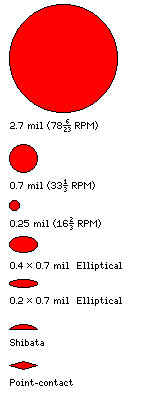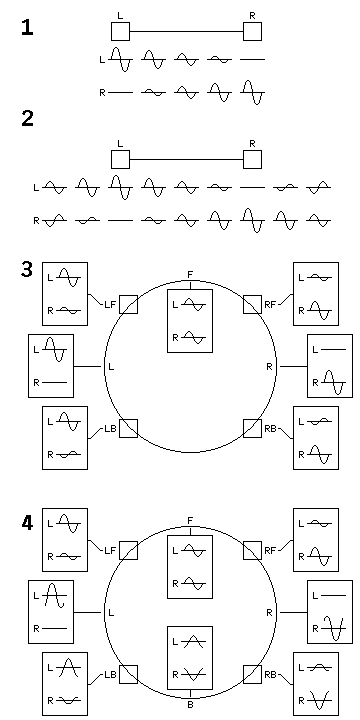
In the beginning, on a 78 RPM (well, OK, actually about 78.26087 RPM, as geared down at a 1:46 ratio from 3,600 RPM: that is, 78 6/23 RPM, at least in Canada and the U.S., where we have 60 Hz electricity; in Europe, where electricity is at 50 Hz, about 77.922078 RPM, geared down at a 2:77 ratio from 3,000 RPM, that is, 77 71/77 RPM) record, the groove moved from side to side to represent the sound, and the needle followed it.

Except that wasn't quite the beginning. Before the Berliner Gramophone, there were Edison cylinder records, sold under the Phonograph trademark. Yes, Virginia, there's a reason why copyright notices refer to phonograph records; it is the trademark of the first audio recordings that has become the generic term.
And on Edison cylinder records, the groove moved up and down to represent sound. This might have been considered more vulnerable to dust on the record than a side-to-side groove. Certainly, it could not be reproduced by the Berliner process, where a wax coating was removed, and then acid was used to etch the disk master. However, that process was itself inherently noisy, and was soon abandoned.
What is inarguable, however, is that cylinders are more bulky than disks. Edison made his own format of disk recordings, which used a constant linear velocity instead of constant angular velocity, and grooves that were still vertically modulated. This is not unlike how modern-day video discs work, or how the Compact Disk and the DVD work to encode very high-frequency digital signals.
Since the stylus on a record player can move both up and down as well as side by side, this could potentially present an opportunity to place additional information on a record.
And the Westrex 45-45 process, on which stereo LPs and singles are produced, did exactly that. Side-by-side motion of the stylus represented the sum of the left and right channels, and up-and-down motion represented the difference. Since both motions were to the same scale, rotating one's frame of reference by 45 degrees, one sees that the stylus has two independent directions of motion, separated by a right angle, one for the left channel, and one for the right.
Stereo sound was first introduced before this process was developed, with pre-recorded reel-to-reel audio tapes. Quadraphonic sound also began with discrete tape formats, in this case a version of the 8-track tape cassette. And both stereo and quadraphonic sound were inspired by the techniques used with motion pictures.
But it was possible for the 33 1/3 RPM vinyl LP to take the next logical step in its evolution. The CD-4, for "compatible discrete 4", record added an ultrasonic signal to both channels on the record, which contained the difference between the front and back signals for the left and right sides. This signal had its carrier at 30 kHz. This required a disc playback system with a frequency response of up to 45 kHz, which meant that a stylus with a narrow profile, rather than a conical stylus, had to be developed, and one was, called the Shibata stylus. This stylus was produced by cutting a conical stylus at an angle, creating a flat elliptical face, and possibly then making a second similar cut, as described in U.S. patent 3,774,918. The difference signal extended to 15 kHz, while the main audio signal had a frequency response of 18 kHz; the lower sideband of the difference signal extended for only 10 kHz, therefore, which means that the difference signal was encoded using a vestigial sideband, just like television.

Equipment for playing back CD-4 disks was expensive, as their playback was a technical challenge. While the frequency response of the cartridge still has to be high, likely requiring a moving-coil design in any case, and the use of a different speed would call compatibility into question, which of course explains why it was not done, the need for a novel and expensive type of stylus might have been avoided by recording CD-4 records at 78 6/23 RPM, but still using an 0.7 mil microgroove stylus, rather than the 2.7 mil stylus used for 78 RPM records. Some records were made this way, but of course not with CD-4 encoding, at the dawn of the LP era. Or one could have compromised by, say, recording them at 45 RPM, but using the ultra-microgroove 0.25 mil stylus developed for 16 2/3 RPM records for playing in cars! As it wasn't until many years later that improved magnetic alloys made high-output moving-coil cartridges possible, though, such measures might not have been felt to be worth the trouble. The illustration on the left compares the types of styli available for record playback; for the conical styli, for example, the circle represents the boundary at which the conical body of the stylus is replaced by the spherical tip.
Because of the technical challenges involved in the playback of 33 1/3 RPM CD-4 records, alternative methods of placing quadraphonic sound on the vinyl record were developed, the matrix quadraphonic systems.
Only two independent channels were provided on records in these formats. It is not possible, of course, to solve four equations in two unknowns. Given this stark, unalterable fact, it is only natural that some consumers at the time may have assumed that matrix quad was simply a titanic hoax that the electronics industry was trying to perpetrate on consumers. But that was not really true; things weren't that simple.

And why weren't they that simple?
Other skeptical consumers might have noted that they only had two ears, which meant that only two channels were really necessary, and thus concluded that there was really no point to quadraphonic sound in any format. Even if we don't accept that judgement, there might at least be a point to it that suggests that matrix quad might be good for something after all.
One thing about quadraphonic sound that might be noted is that the four speakers used in a quadraphonic setup were not positioned at the four vertices of a tetrahedron surrounding the listener. Had they been, then four discrete channels would have been required to cause sounds to seem to come to the listener from any direction, from left or right, from before and behind, and from above and below. Instead, they were at the four corners of a square.
Thus, their goal was simply to cause sounds to come from any location on a circle surrounding the listener. In two-channel stereo, sounds were caused to come from any part of a straight line between the speakers in front of the listener.
A straight line can be bent into a circle.
This is the basic fact that explains why two channels contained the information that was needed for quadraphonic sound. Just how the line between the speakers was bent is shown by the illustration on the right.
Section 1 of the diagram shows how stereo works. Depending on whether a sound consists only of a signal to one of the speakers, or an equal signal to both, the perceived position of that sound varies from at one of the speakers to exactly between them. Incidentally, the power of a signal is proportional to the square of its amplitude, but this fact has been ignored in the diagram to make it easier to understand at a glance.
Section 2 shows that if the signals to the two speakers are opposite in phase, the line between the speakers could actually extend beyond them. However, if the two signals are also equal in strength, there is no way to determine if the sound should be coming from the extreme left or the extreme right, so the two outermost waveform illustrations show an inaccessible limit.
Section 3 illustrates the "regular matrix" quadraphonic system. The line between the two loudspeakers in stereo has been bent, not into a circle, but into a semicircle, and the extensions beyond the two speakers, when the signals to the two speakers are opposite in phase, are bent to form the rest of the circle.
When the two signals are equal and opposite in phase, it is now clear where the sound is coming from; behind the listener. But this system doesn't provide a consistent relationship of phase to position; if a sound source moves around the listener, passing the point behind the listener, its phase will end up getting suddenly reversed, at least if it is being picked up by a quadraphonic microphone setup, instead of being panned electronically. It's a little bit like crossing the International Date Line.
Section 4 illustrates how this problem was solved. This part of the diagram attempts to illustrate the QS matrix quadraphonic system developed by Sansui.
The signals to be sent to the two rear speakers were, in the recording studio, altered in phase by 90 degrees. Since twice 90 degrees is 180 degrees, the embarassing 180 degree phase flip-flop behind the listener was avoided.
Matrix quadraphonic records were intended to be compatible with conventional stereo records. In a stereo listening setup, the two speakers are usually in front of the listener, rather than directly on the listener's right and left. Thus, other matrix quadraphonic systems existed which were variations on the two systems described here, imposing a distortion on the circle of sound so that the left and right channels were moved towards the left front and right front speakers.
Also, while the ear cannot directly detect the phase of sound waves, because the ear is not entirely linear in its response, the relative phase of signals of different frequencies can affect how a sound is heard. A sharp transient peak will overload the ear, and hit its nonlinearities, but if its component frequencies are shifted in phase, those nonlinearities would be encountered to a lesser extent.
Audio purists, therefore, had problems with all the quadraphonic systems offered for records as opposed to tapes. Some systems involved deliberate phase manipulations. Others avoided this, but forced the studio in some cases to construct at least part of the soundscape around the listener artificially. And the available discrete quad system, which avoided both of those problems, had limited frequency response.
For the average consumer, having too many formats to choose from, not having a clear reason to upgrade, and the problem of placing two more speakers in the living room all contributed to the ultimate historical fate of quadraphonic sound.
However, since some of us are putting in extra speakers to hear surround sound from our DVD players, the basic techniques involved are making a comeback of sorts.